Holder of National Intangible Cultural Heritage, Ox Horn Inlaying, Lee Jae-man
World’s Only art, Hwagak(Ox Horn Inlaying)
국가무형유산 화각장 보유자 이재만
세계 유일의 예술, 화각
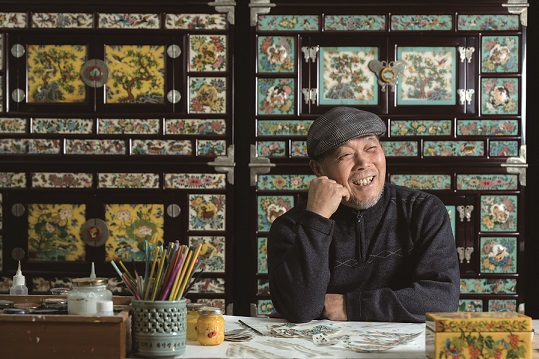
Hwagak means “splendid horn.” It is a traditional Korean art and technique unique to Korea. The splendid works created by adding numerous processes to the distinctive material of ox horn are enough to capture our attention. Here is a man who continues this tradition so it does not perish.
화려할 화(華), 뿔 각(角) 자를 써 화려한 뿔이라는 뜻을 지닌 화각. 전통예술이자 전 세계에서 오직 한국에만 존재하는 기법이다. 독특한 재료인 쇠뿔에 수많은 과정을 더해 만들어진 화려한 작품은 우리의 눈길을 사로잡기에 충분하다. 그리고 이 전통이 사라지지 않도록 이어가는 이가 있다.
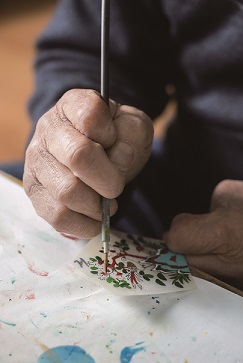
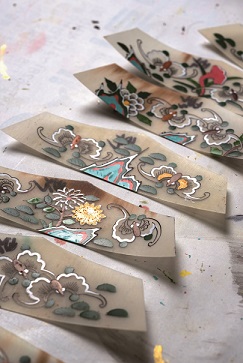
Hands Carving Art on Ox Horn 쇠뿔에 예술을 새기는 손길
Lee Jae-man, a hwagakjang(master of ox horn inlaying), is an artisan who continues the Korean ox horn inlaying craft tradition. Hwagak is a traditional craft in which a picture is drawn on a thin, transparent plate made of ox horn and then attached to furniture, small items, etc. as decoration. Since the material was expensive and the process was complex, it was mainly used for items belonging to royalty or a few aristocrats. It was by chance that Lee learned the techniques of this rare craft. A friend who delivered newspapers to his teacher, the late Eum Il-cheon, spkoe of the art, and he happened to visit and come into contact with hwagak.
이재만 화각장은 한국의 화각 공예의 맥을 잇는 장인이다. 화각은 쇠뿔을 얇게 갈아 투명하게 만든 판에 그림을 그린 뒤 가구, 소품 등에 붙여 장식하는 전통공예품으로, 재료가 귀하고 공정이 까다로워 왕족이나 특수 귀족층들의 물품에 주로 활용됐다. 쉽게 볼 수 없는 공예품의 기술을 그가 배우게 된 것은 우연이었다. 스승이었던 고(故) 음일천 선생님 집으로 신문배달을 하던 친구가 그에 대해 말했고, 얼떨결에 방문하면서 화각을 접하게 된 것이다.
Lee was not particularly drawn to hwagak at first. “My grandfather was a dancheong(ornamental painting) artist, my father was a daemokjang(traditional wooden architecture) master, and my mother was a jasu (embroidery) artist. I was naturally exposed to traditional arts, so painting on ox horn did not seem extraordinary. I just went to learn under my teacher at home because my parents told me to.” However, the artisic gift carried through generations blossomed his talent, and he gradually learned ox horn inlaying following where his fate led him. Since then, Lee was recognized as a national intangible cultural Heritage holder in 1996 and has continued the tradition.
이재만 화각장은 처음에는 화각에 대해 매력을 느끼지 못했다. “할아버지는 단청을, 아버지는 대목장을, 어머니는 자수를 했습니다. 전통예술을 자연스럽게 접하고 있어 화각의 그림이 제게 특별하진 않았어요. 그저 집에서 배우라고 해서 선생님 밑으로 들어갔습니다.” 그러나 대대로 흐르는 예술적 피는 그의 재능을 꽃피웠고 운명적 흐름에 따라 자연스럽게 화각을 익혀갔다. 이후 1996년 국가무형유산 보유자로 인정되어 지금껏 그 전통을 이어가고 있다.
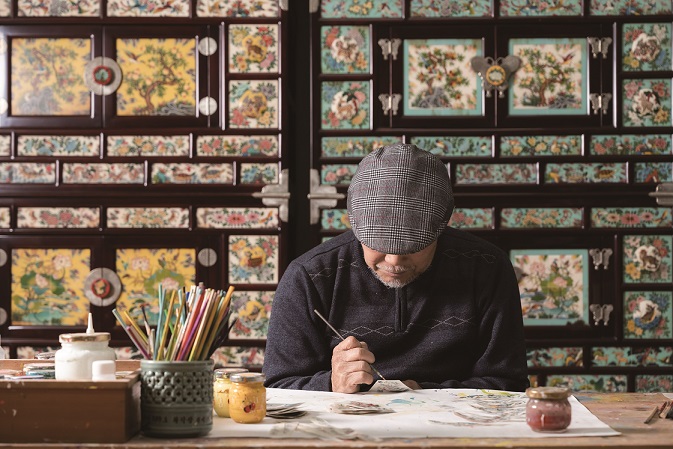
Work Created through Difficult Processes 까다로운 공정을 거친 작품
The material for hwagak comes from just one type of horn—the horn of a two-three-year-old bull native to Korea. The horns of other cows tend to be curved or translucent, making them unsuitable for use. Even among bulls of the same age, those that have grazed naturally produce horns that are more rigid and transparent than those fed grain. Lee says finding quality materials has become increasingly challenging as most cattle are fed grain nowadays.
화각의 재료가 되는 쇠뿔은 하나다. 한국에서 자생하는 황소로 2~3년생 수소의 뿔이다. 다른 소의 뿔들은 구부러져 있거나 투명하지 않아 쓸 수 없기 때문이다. 또한 같은 연생이라도 풀을 먹은 소가 사료를 먹은 소보다 뿔이 단단하고 투명하다. 요즘은 대부분 사료를 먹이기에 갈수록 좋은 재료를 구하기가 어렵다고 이재만 화각장은 난색을 표했다.
Just as a canvas is essential for painting, a plate must be made of a horn for hwagak. He considers this process, known as ‘gakji,’ which treats horns like paper, the most crucial step. First, the horn is boiled in hot water to remove the flesh and bones. The end of the hollow horn is then cut off, dried, baked, and pressed flat using a compressor. Next, the surface of the horn is smoothed and thinned, a process called the ‘golgak’. The thick horn is continuously ground down until it resembles thin paper. Since the final image appears on the reverse side of the colored surface, the thinner the horn, the more precise the image becomes. It requires meticulous effort to create a superior piece of hwagak.
그림을 그리려면 캔버스가 필요한 것처럼 화각을 하기 위해서는 쇠뿔로 판을 만들어야 한다. 뿔을 종이처럼 가공하는 ‘각지’로 그는 이 과정을 가장 중요하게 여긴다. 먼저 쇠뿔을 뜨거운 물에 푹 삶아 살과 뼈를 분리한다. 속이 빈 뿔은 끝을 잘라내 말린 뒤 구워서 펴고 압축기로 눌러 판판하게 만든다. 이후 펼쳐진 쇠뿔의 표면을 갈아 얇게 깎는 골각 과정을 거친다. 두꺼웠던 뿔을 얇은 종이가 될 때까지 쉼 없이 갈아낸다. 화각은 색을 칠한 면의 반대편에서 완성된 그림이 나타나기에 두께가 얇을수록 그림의 선명도가 높아진다. 그야말로 뼈를 깎는 노력을 이뤄내야 더 좋은 화각 작품을 완성할 수 있는 것이다.
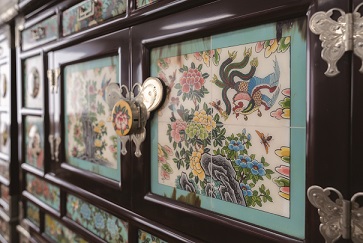
Making Changes to Reach the World 세계로 나아가기 위한 변화
Lee Jae-man's hwagak works are remarkably diverse. He showcases a variety of plants and animals commonly found in folk art, including the ten symbols of longevity, clouds and dragons design, clouds and phoenixes designs, and auspicious patterns, as well as peonies, pomegranates, chrysanthemums, butterflies, and bees. “I invest a lot of thought into crafting my designs. The image should suit the item's purpose. I choose the appropriate design depending on whether it will be used at a wedding, who will receive it, and the story I intend to convey.” This is why he believes hwagak is an art form that tells a beautiful narrative.
이재만 화각장의 화각 그림은 다채롭다. 십장생과 운룡, 운봉, 길상 무늬를 비롯해 모란, 석류, 국화, 나비, 벌 등 민화에 등장하는 각종 동식물을 새긴다. “도안을 창작하기 위해 고민을 많이 합니다. 물건의 용도에 따라 그림이 달라져야 하니까요. 결혼식에 사용할 건지, 누구에게 선물하는지, 무슨 이야기를 전하고 싶은지에 따라 맞는 그림을 그려 넣습니다.” 화각 공예가 아름다운 이야기를 담아내는 예술작품이라고 말하는 이유다.
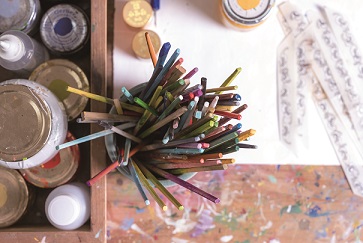
Additionally, he is striving to globalize hwagak. He is moving beyond the traditional red and yellow palette to incorporate a broader range of colors. Along with the five cardinal colors and green, he uses purple, gray, and other hues, or creates unique colors. Rather than simply reproducing traditional crafts, he creates beauty that resonates with people worldwide. These efforts began with an invitation to an exhibition in India in 1979, leading to numerous international exhibitions in the United States, Japan, France, Germany, Russia, and China. He notes that it is meaningful that people around the globe appreciate the beauty of hwagak and recognize its value.
또한 그는 화각의 세계화를 위해 노력하고 있다. 주로 적색과 황색만 사용하는 것에서 벗어나 색을 다채롭게 사용한다. 오방색과 간색 외에도 보라색, 회색 등으로 칠하거나 특별한 색깔을 만든다. 전통공예 재현에 그치지 않고 전 세계인들이 공감할 수 있는 아름다움을 창작하는 것이다. 이러한 시도는 1979년 인도에서 열리는 전시회 작품 초대를 시작으로 미국, 일본, 프랑스, 독일, 러시아 중국 등 수십 차례의 해외 전시로 이어졌다. 그는 전 세계인들이 화각 공예의 아름다움에 감탄하고 가치를 알아주고 있어 뜻깊다고 전했다.
+ Box
Cultural heritage is preserved and passed down to future generations, including intangible heritage. In particular, culture and art are transmitted through people and techniques. Incheon has a space that supports preservation and even offers hands-on experiences—Discover Korea’s unique beauty and culture at the Incheon Intangible Cultural Asset Learning Education Center.
다음 세대로 계승하기 위해 지켜가는 문화유산. 그 안에는 형태가 없는 것도 존재한다. 특히 문화·예술은 사람을 통해 기술로 전해진다. 인천에는 이를 보존하고 더 나아가 직접 경험할 수 있도록 지원하는 공간이 있다. 인천무형유산 전수교육관에서 한국 고유의 아름다움과 문화를 만나보자.
# Address: 599 Maesohol-ro, Michuhol-gu, Incheon [Hwagakjang: B1, Rm. B104] 주소 : 인천 미추홀구 매소홀로 599 [화각장 : 지하1층, B104호] # Hours of operation: Tuesday-Sunday 9:00-18:00 (Closed every Monday) 운영시간 : 화~일 9:00~18:00(매주 월요일 휴무) # Price: Free 관람료 : 무료 # Website: www.incheon.go.kr/culture/CU030101 홈페이지 : www.incheon.go.kr/culture/CU030101 |